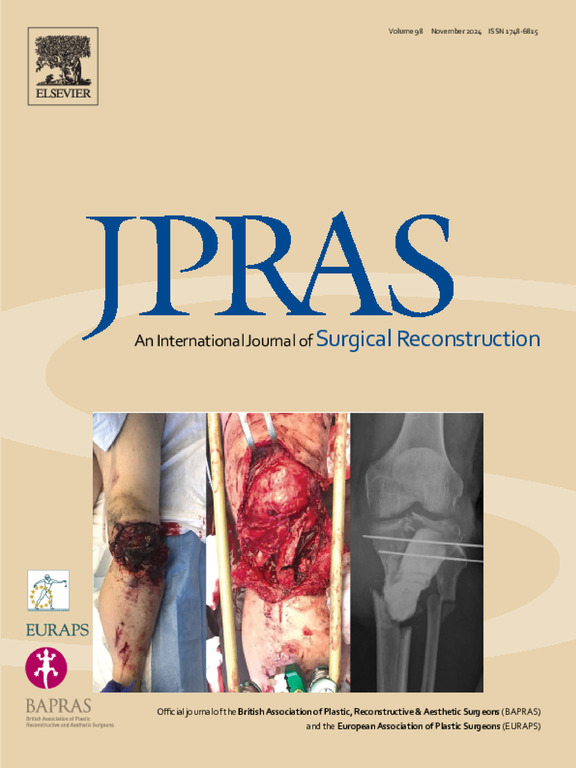Long-term follow-up after DIEP flap breast reconstruction: Quality of life with a focus on donor-site morbidity
IF 2.4
3区 医学
Q2 SURGERY
Journal of Plastic Reconstructive and Aesthetic Surgery
Pub Date : 2025-07-07
DOI:10.1016/j.bjps.2025.06.035
引用次数: 0
Abstract
Background
The DIEP flap is widely used for breast reconstruction post-mastectomy, known for its superior aesthetic results. Given the variety of reconstruction options available, evaluation of donor site satisfaction is essential for informed patient counseling and decision-making. This study assesses the overall quality of life and long-term patient satisfaction with the abdominal donor site after DIEP flap breast reconstruction.
Methods
This retrospective cross-sectional study at Maastricht University Medical Center identified patients who underwent DIEP flap breast reconstruction over the past 15 years. Data mining tools searched electronic medical records for relevant procedures. Eligible participants received an online questionnaire using validated Dutch translations of the BREAST-Q and BODY-Q to measure satisfaction and physical well-being of the abdomen. Statistical analyses were performed using SPSS 29.0, employing multiple linear regression to investigate associations between demographic and clinical variables and satisfaction scores.
Results
A total of 563 questionnaires were initiated, and 470 patients were included for further analysis. The mean age at surgery was 51.5 years, with a mean BMI of 26.8. Patients reported high aesthetic satisfaction but experienced functional discomfort. Significant correlations were found between BMI, age, comorbidities (diabetes, hypertension), and satisfaction scores.
Conclusion
This study on DIEP flap breast reconstruction highlights high aesthetic satisfaction despite functional discomfort, with satisfaction decreasing as BMI increases. It underscores the importance of pre-operative weight management, individualized patient counseling, and consideration of age and comorbidities to optimize post-surgical satisfaction. The unexpected positive correlations between diabetes, hypertension, and satisfaction scores warrant further investigation.
DIEP皮瓣乳房重建术后的长期随访:生活质量与供体部位发病率的关系
DIEP皮瓣以其优越的美学效果被广泛应用于乳房切除术后的乳房重建。鉴于多种重建选择,评估供体部位满意度对于知情的患者咨询和决策至关重要。本研究评估DIEP皮瓣乳房重建后患者对腹部供区整体生活质量和长期满意度。方法在马斯特里赫特大学医学中心进行回顾性横断面研究,确定了过去15年中接受DIEP皮瓣乳房重建术的患者。数据挖掘工具搜索电子病历查找相关程序。符合条件的参与者收到一份在线问卷,使用经过验证的荷兰语BREAST-Q和BODY-Q翻译来衡量腹部的满意度和身体健康。采用SPSS 29.0进行统计学分析,采用多元线性回归分析人口学、临床变量与满意度评分之间的关系。结果共发放问卷563份,纳入470例患者进行分析。手术时的平均年龄为51.5岁,平均BMI为26.8。患者报告审美满意度高,但经历功能不适。BMI、年龄、合并症(糖尿病、高血压)和满意度评分之间存在显著相关性。结论DIEP皮瓣乳房再造术在功能不适应的情况下具有较高的审美满意度,且满意度随BMI的增加而降低。它强调了术前体重管理、个体化患者咨询以及考虑年龄和合并症对优化术后满意度的重要性。糖尿病、高血压和满意度之间意想不到的正相关关系值得进一步研究。
本文章由计算机程序翻译,如有差异,请以英文原文为准。
求助全文
约1分钟内获得全文
求助全文
来源期刊
CiteScore
3.10
自引率
11.10%
发文量
578
审稿时长
3.5 months
期刊介绍:
JPRAS An International Journal of Surgical Reconstruction is one of the world''s leading international journals, covering all the reconstructive and aesthetic aspects of plastic surgery.
The journal presents the latest surgical procedures with audit and outcome studies of new and established techniques in plastic surgery including: cleft lip and palate and other heads and neck surgery, hand surgery, lower limb trauma, burns, skin cancer, breast surgery and aesthetic surgery.

 求助内容:
求助内容: 应助结果提醒方式:
应助结果提醒方式:


